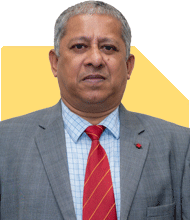Ramalingam Kalirajan |9255 Answers |Ask -Follow
Mutual Funds, Financial Planning Expert - Answered on Apr 13, 2024
He has an MBA in finance from the University of Madras and is a certified financial planner.
He is the director and chief financial planner at Holistic Investment, a Chennai-based firm that offers financial planning and wealth management advice.... more

Sir I am 49 years, I am taking VRS in Dec 2024 due to some health issues. I will get Rs. 1.12 cr (without commutation) and pension of 65000+. I wish to get 60000 extra per month on average from the above amount. My expenses would be managed from pension. Please suggest plan for the goal. I can do SWP for maximum 30 lakh.
Achieve a monthly income of Rs. 1.25 lakh (pension + desired income) after taking VRS.
Challenges:
Generating this income solely from your VRS amount (Rs. 1.12 crore) and a conservative withdrawal rate (like 5%) might be difficult.
Possible Solutions:
Adjust Withdrawal Rate: Consider a slightly lower withdrawal rate to stretch your VRS amount further.
Explore Additional Income: Look for ways to generate some additional income, even part-time work, to bridge the gap.
Strategic Investment: Utilize the SWP facility for a portion of your VRS amount and invest the remaining amount in a mix of debt and equity (depending on your risk tolerance) to potentially earn higher returns.
Key Points:
Financial Advisor: Consulting a registered financial advisor is highly recommended. They can personalize a plan based on your specific situation and risk tolerance.
Market Fluctuations: Remember, market returns can fluctuate. Ensure your plan considers potential risks.
By considering these points and seeking professional advice, you can create a more realistic and sustainable plan to achieve your desired income after taking VRS.
You may like to see similar questions and answers below
Ramalingam Kalirajan |9255 Answers |Ask -Follow
Mutual Funds, Financial Planning Expert - Answered on May 01, 2024
Ramalingam Kalirajan |9255 Answers |Ask -Follow
Mutual Funds, Financial Planning Expert - Answered on Dec 27, 2024
T S Khurana |487 Answers |Ask -Follow
Tax Expert - Answered on Feb 26, 2025
Ramalingam Kalirajan |9255 Answers |Ask -Follow
Mutual Funds, Financial Planning Expert - Answered on Dec 30, 2024
Ramalingam Kalirajan |9255 Answers |Ask -Follow
Mutual Funds, Financial Planning Expert - Answered on Jun 02, 2025
Prof Suvasish Mukhopadhyay |1858 Answers |Ask -Follow
Career Counsellor - Answered on Jun 27, 2025
Prof Suvasish Mukhopadhyay |1858 Answers |Ask -Follow
Career Counsellor - Answered on Jun 27, 2025
Prof Suvasish Mukhopadhyay |1858 Answers |Ask -Follow
Career Counsellor - Answered on Jun 27, 2025
Prof Suvasish Mukhopadhyay |1858 Answers |Ask -Follow
Career Counsellor - Answered on Jun 27, 2025
Prof Suvasish Mukhopadhyay |1858 Answers |Ask -Follow
Career Counsellor - Answered on Jun 27, 2025
Prof Suvasish Mukhopadhyay |1858 Answers |Ask -Follow
Career Counsellor - Answered on Jun 27, 2025
Prof Suvasish Mukhopadhyay |1858 Answers |Ask -Follow
Career Counsellor - Answered on Jun 27, 2025
Prof Suvasish Mukhopadhyay |1858 Answers |Ask -Follow
Career Counsellor - Answered on Jun 27, 2025
Prof Suvasish Mukhopadhyay |1858 Answers |Ask -Follow
Career Counsellor - Answered on Jun 27, 2025
Dr Nagarajan J S K |1366 Answers |Ask -Follow
NEET, Medical, Pharmacy Careers - Answered on Jun 27, 2025


















